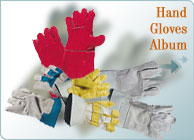 |
 |
|
|
|
 |
Hand Gloves
Hands at work are extremely vulnerable to a wide range of hazards which
include cuts, blows, chemical attack and temperature extremes.
With industry's increasingly complex and sensitive manufacturing and handling
processes, there is a growing insistence on the use of "job fitted"
safety gloves that meet each of the users' specific requirements.
Hence we offer a wider and more comprehensive range of safety gloves -
in excess of 200 different types and styles from which to choose. |

Checkout the Hand Gloves Album |
European Standards
 Implies that the
gloves comply with the basic requirements laid down by the EEC directive:
Personal Protective Equipment. Implies that the
gloves comply with the basic requirements laid down by the EEC directive:
Personal Protective Equipment.
Simple Design (Category 1)
For areas of 'minimal risk' where the effects of not wearing a glove are
easily reversible or superficial. Such products are self certified.
Intermediate Design (Category 2)
For areas of specific risk i.e. mechanical risks. Such products will have
been EC type tested against European test methods and certified by a notified
body.
Complex Design (Category 3)
For areas/applications that can seriously or irreversibly harm the health.
Such products, in addition to the CE type test will also have to be either
produced under an approved quality system OR be typed tested on an annual
basis.
EN 388 - This standard applies to all kinds of protective
gloves giving protection from mechanical risks, in respect of physical problems
caused by abrasion, blade cut, puncture, or tearing. This standard also
covers risk of electrostatic discharge.
EN 374 - This standard
specifies the capability of gloves to protect the user against chemicals
and/or micro-organisms.
EN 511 - This standard applies to
gloves which protect the hands against convective and contact cold.
EN 407 - This standard specifies thermal performance for protective
gloves against heat and/or fire.
EN 659 - This standard
defines performance requirements for gloves designed to protect fire fighters
against heat and flames.
If a glove is to be used for food handling, it is required to carry either
the words 'for food use' or this symbol. |
Hazards & Performance
Levels
Mechanical Hazards
EN 388 |
Perf.
Level |
| a) Abrasion resistance |
0-4 |
| b) Blade-cut resistance |
0-5 |
| c) Tear resistance |
0-4 |
| d) Puncture resistance |
0-4 |
Cold
EN 511 |
Perf.
Level |
| a) Convective cold |
0-4 |
| b) Contact cold |
0-4 |
| c) Water proofness |
0-1 |
Thermal Hazards
EN 407 |
Perf.
Level |
| a) Burning behaviour |
0-4 |
| b) Contact heat |
0-4 |
| c) Convective heat |
0-4 |
| d) Radient heat |
0-4 |
| e) Small splashes of molten metal |
0-4 |
| f) Large splashes of molten metal |
0-4 |
|
Contact Heat
A sample is taken from the palm area of a glove. The outside of the glove
is put on a hot surface and the temperature of the inside of the glove is
then monitored. The temperature on the inside of the glove must take 15
seconds or more to rise by 10C from room temperature. |
EN 407
Perf.
Level |
Contact
Temp.
ToC |
Threshold
Time
secs |
| 1 |
100 |
>15 |
| 2 |
250 |
>15 |
| 3 |
350 |
>15 |
| 4 |
500 |
>15 |
|
Maintenance
Contaminated and worn gloves may fail to protect the hands from the very hazard
they were designed for. Effective protection is maintained by regular replacement
of the gloves. Check the condition of the gloves, inside and out.
» Checkout the Hand Gloves album. 
|
About | Contact | Sitemap
| Disclaimer
© YESS 2007-08. All rights reserved. yes2yess.com
: eServices : corporateWWWDEVplug
 |
 |

